THE APPLICATION OF IOT (INTERNET OF THINGS) FOR SMART HOUSING ENVIRONMENTS AND INTEGRATED ECOSYSTEMS
Abstract
Abstrak_ Perkembangan teknologi meningkat pesat seiring berjalannya waktu. Mulai dari mobil pintar yang bisa berjalan sendiri ke berbagai tujuan tanpa pengemudi, hingga perangkat rumah pintar yang bisa secara otomatis bersuara mengingatkan untuk melakukan aktifitas sesuai jadwal. Semua teknologi terbaru ini adalah bagian dari Internet of Things. Internet of Things (IoT) adalah konsep dimana objek memiliki kemampuan untuk mentransfer data melalui jaringan tanpa memerlukan interaksi dari manusia ke manusia atau dari manusia ke komputer. IoT adalah struktur dimana, orang diberi identitas eksklusif dan kemampuan untuk memindahkan data melalui jaringan tanpa memerlukan dua arah antara manusia ke manusia, sumber ke tujuan atau interaksi antara manusia dan komputer. Jadi, penelitian ini bertujuan untuk mengidentifikasi dan menjelaskan penerapan sistem IoT dalam mendukung program smart building dan lingkungan yang terintegrasi. Penelitian ini dianalisis secara deskriptif kualitatif dengan pendekatan studi kasus untuk mengeksplorasi manfaat teknologi IoT. Hasil penelitian ini menunjukkan dengan menghubungkan sistem bangunan yang berbeda dengan sensor dan perangkat IoT yang terhubung ke jaringan, aplikasi bangunan pintar untuk lingkungan perumahan pintar, dan ekosistem dapat terintegrasi menggunakan data lintas operasi, memberikan visibilitas yang lebih besar, wawasan cepat, dan pengalaman penghuni yang lebih baik. Teknologi IoT dapat bekerja dengan baik jika interaksi antara perangkat IoT dengan manusia atau pengguna harus berjalan dengan baik, karena IoT tidak akan berfungsi secara optimal jika pengguna tidak dapat mengoperasikannya dengan baik.
Kata kunci: Internet of Things (IoT); Bangunan Pintar; Lingkungan Perumahan Pintar; Ekosistem Terpadu, Sistem Bangunan.
Abstract_ Technological development increases rapidly over time. Starting from smart cars that can walk alone to various destinations without a human driver, to smart home devices that can automatically remind the voice to do activities on schedule. All of this latest technology is part of the Internet of Things. Internet of Things (IoT) is a concept where objects can transfer data through networks without requiring interaction from human to human or from human to computer. IoT is a structure in which objects, people are given an exclusive identity and the ability to move data through networks without requiring two directions between humans to humans, that is, sources to destinations or interactions between humans and computers. So, this research aims to identify and explain the application of the IoT system in support of smart building programs and integrated environments. This study was analyzed descriptively qualitative with a case study approach to explore the benefits of IoT technology. The results of this study indicate by connecting disparate building systems with networked IoT sensors and devices, smart building applications for smart housing environments and integrated ecosystems can use data across operations, providing greater visibility, valuable insights, and better occupant experiences. IoT technology can work well if the interaction between IoT devices with humans or users must go well because the function of IoT will not work optimally if the user cannot operate it properly.
Keywords: Internet of Things (IoT); Smart Building; Smart Housing Environment; Integrated Ecosystems, Building Systems.
Downloads
References
Fachrizal, Rafki. 2019. “The Important Role of Technology in Supporting the Existence of Smart Buildings.” The latest news page Infokomputer. 2019. https://infokomputer.grid.id/read/121665861/peran-penting-teknologi-dalam-mendukung-hadirnya-bangunan-pintar?page=all.
Friedman, Felix. 2016. “Microsoft IoT for Smart Buildings.” YouTube video. 2016. https://www.youtube.com/watch?v=CEAyzkuuAQ8&feature=youtu.be .
Indonesia, Telkom. 2020. “M2M (Machine to Machine) / IoT (Internet of Things). . . Enterprise Service Division.” Indonesia: Telkom Catalog. PT Telkom Indonesia Tbk.
Lawi, Armin, dan Sya’Rani Machrizzandi M. 2018. “Facial Expression Recognition using Multiclass Ensemble Least-Square Support Vector Machine.” IOP Conf. Series: Journal of Physics: Conf Series 979. https://doi.org/10.1088/1742-6596/979/1/012032.
Lawn, Austinite’s Home. 2019. Smart Home Tour. YouTube video. https://www.youtube.com/watch?v=q--X0CHEe-I.
Saryono. 2010. Qualitative Research Methods (Metode Penelitian Kualitatif). Bandung: PT. Alfabeta.
SoftwareSeni. 2019. “Ready to welcome the Internet of Things (IoT), Indonesia?” BUSINESS. DEV, TECH.
Wang, C, M Daneshmand, M Dohler, X Mao, R. Q Hu, dan H Wang. 2013. “Guest Editorial - Special Issue on Internet of Things (IoT): Architecture, Protocols and Services.” IEEE Sensors Journal 13 (10): 3505–3508. https://doi.org/10.1109/JSEN.2013.2274906.
Copyright (c) 2020 Andi Hildayanti, M Sya'Rani Machrizzandi

This work is licensed under a Creative Commons Attribution-ShareAlike 4.0 International License.
By submitting your manuscript to our journal, you are following Copyright and License











